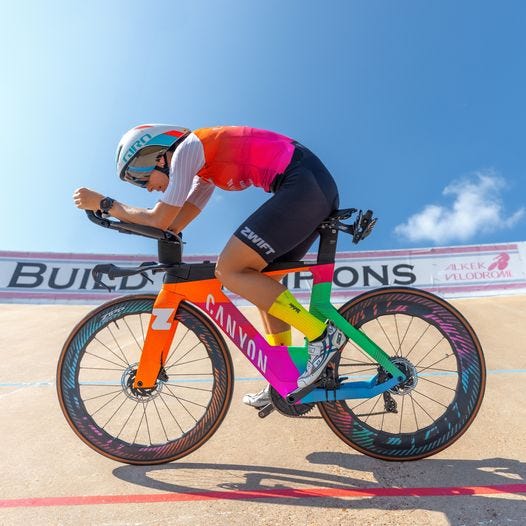Adapting to your Aero position
Having done hundreds of fits at the FreeSpeed lab, when an athlete complains about "not being able to hold their aero position on race day," my first question is, how much did you train and adapt to that aero position?
More often than not, the answers are:
Not as much as I should have.
Only when riding outdoors (not indoors).
Only when I rode my Tri-bike.
Enough, I think...
That is not to say that their current position was optimized and needed adjustments. However, the number of amateur triathletes who need to spend more time adapting to their fit/aero position is relatively high.
On average, an amateur triathlete training for an Ironman may ride three to four times per week. Two may be indoors, so much time may involve riding seating-up. Another possibly on a road bike and a longer weekend ride on the Tri-bike and not all riding aero due to turns, stops due to traffic and to refuel or breaks, grabbing bottles, unable to sustain the position, etc.
Thus, it's easy to illustrate how a significant percentage of the total riding time isn't performed in the aero position and why it may be challenging to sustain said position on race day.
I've always wondered how much higher the energy cost may be for an athlete not adapted to the aero position vs. one that is. Since I have access to metabolic testing equipment, I decided to do a mini n=2 test with Jana and myself.
As usual, this is a quick disclaimer: the information below is primarily for informational purposes and may not apply to you individually.
Subjects:
Jana is in her final build toward the Ironman World Championship, averaging ~25 hours of swim/bike/run/strength per week. She does all her riding indoors during the week and rides long on the weekend, averaging ~12:30 hours per week. She spends the majority of her time riding in the aero position.
And me. I'm currently not training for anything. Specifically, I've been riding indoors two to three times a week for 45-60 min at a time, and 95% or more seating up.
Protocol:
During a 1 hour ride, each did a 20-25 min warm up, then rode at a fixed sub LT1 power for 5 min, either seating up (position A) or aero position (position B) twice as follows: Position A, Position B, Position B, and Position A. We measured the Volume of Oxygen (VO2), & energy expenditure with VO2master, Heart Rate with polar H10, power (Quarq and Assioma Favero), SmO2% of left & right vastus lateralis with Moxy Monitor, and Body core temperature with CORE Body temperature monitor.
Below, you can see the results for each:
When comparing Jana's results to mine, she experiences ~1% higher energy cost when riding aero versus seating up, and her mechanic efficiency loss is even lower. Still, while riding in the aero position may "cost" slightly more than seating up, the aerodynamic gains will benefit you even more.
For instance, when Jana rides sitting up, her drag coefficient is about 30% higher than in the aero position. Riding at ~200w for a course like Ironman Texas that would result in a bike split training ~18 min slower versus riding in the aero position costing her an extra 200kcal total. Therefore, adapting to the aero position is vital for both, energy cost and aerodynamic gains.
On the other hand, it costs me ~4% more energy to ride aero, and the same percentage affects my mechanic efficiency. It is also noticeable how my heart rate is higher when I ride aero as I'm certainly not adapted at the moment, perceived exertion wise, it just feels more challenging.
This is the opposite of when I was training last year for Ironman Waco. And though I don't have specific data from then, from a perceived exertion perspective, I could ride in the aero position for a long time, and it was rather sustainable.
And why I always advise the athletes I fit and or work with to adapt to their aero positions as much as possible. Because doing so will most likely benefit them significantly on race day for both, energy expenditure and aerodynamics. In other words, train like you’ll race!





